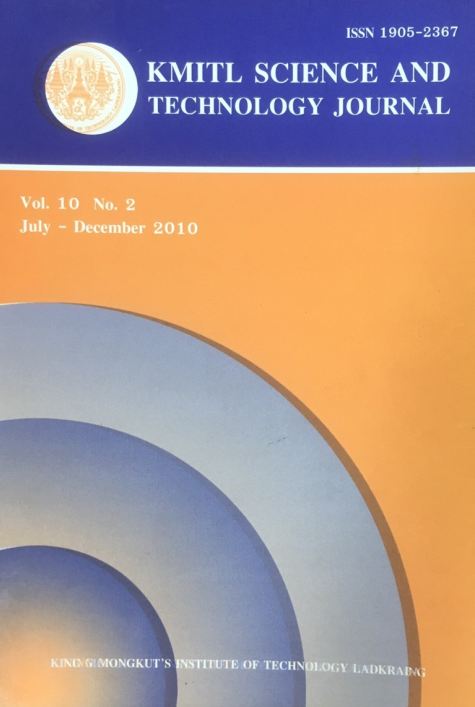The Estimation of Electrical Equivalent Circuit Model and Behaviors of Breakdown of Euglena sanguinea Ehrenberg Stimulated by Multi-Level Electromagnetic Fields
Main Article Content
Abstract
This research studied the complex impedance and permittivities of E. sanguinea by measuring the RC impedance and then calculated and compared to measured values by Cole-Cole plot. The objective of this study were to build a new electrical equivalent circuit model from RC circuit model of E. sanguinea with MEM and explain behaviors of breakdown of E. sanguinea by mean of critical frequency, critical voltage, critical electric field, breakdown electric which were stimulated by MEM. The results revealed that there were a correlation between impedance from measurement and simulation with correlation value equal to 0.89. The RC impedance of E.
sanguine of each chemical component was behavioral in semicircle varied to frequency. The model can be used for design of wastewater treatment system by MEM such as treating algae bloom water. This is an innovative electric simulation applicable to the electric engineering and other related fields.
Keyword: Multi-Level Electromagnetic Fields (MEM), complex impedance, electric field, Euglena sanguinea, resonance frequency
E-mail: s6060202@kmitl.ac.th
Article Details
Copyright Transfer Statement
The copyright of this article is transferred to Current Applied Science and Technology journal with effect if and when the article is accepted for publication. The copyright transfer covers the exclusive right to reproduce and distribute the article, including reprints, translations, photographic reproductions, electronic form (offline, online) or any other reproductions of similar nature.
The author warrants that this contribution is original and that he/she has full power to make this grant. The author signs for and accepts responsibility for releasing this material on behalf of any and all co-authors.
Here is the link for download: Copyright transfer form.pdf
References
[2] ISO 10260. 1992. Water quality-measurement of biochemical parameters spectrometric determination of the chlorophyll a concentration, international standard, technical committee ISO/TC 147. Water quality, sub-committee SC2 Geneva, Ch-1211.
[3] Hames, B. D. and Rickwood, D. 1990. Gel Electrophoresis of Proteins: A Practical Approach. IRL Press, Oxford.
[4] Bradford, MM. 1976. A rapid and sensitive method for the quantization of microgram quantities of protein utilizing the principle of protein-dye binding. Anal. Biochemical, 72,248-254.
[5] American Health Association, American Water Works Association, Water Environment Federation. 1998. Standard Methods for the Examination of Waste Water and Wastewater,20th Ed., Washington DC.
[6] Frag, F. and Pérez, F. F. 1990. Transformaciones entre composición química del fitoplancton. composición elemental yrelación de Redifield. Scientia Marina, 54, 69-76.
[7] Ríos, A. F., Fraga, F., Pérez. F. F. and Figueiras, F. G. 1998. Chemical composition of phytoplankton and particulate organic matter the Ría de Vigo (NW Spain). Scientia Marina,62(3), 257-271.
[8] Grasshoff, K., Ehrhardt. M. and Kremling, K. 1952. Methods of Seawater Analysis. 2a ed. Verlag Chemie, Weinheim.
[9] Pan, L. K., Huang, H. T. and Chang, Q. Sun. 2003. Dielectric relaxation and transition of porous silicon. Journal of Applied Physics, 94, 2696-2700.
[10] Moulson, A. J. and Herbert, J. M. 2003. Electroceramic. Second Edition. John Wiley & Sons Ltd.
[11] Dejmek, P. and Miyawaki, O. 2002. Relationship between the electrical and rheological properties of potato tuber tissue after various forms of processing. Biosci. Biotechnol. Biochem, 66(6), 1218-1223.
[12] E, Thomas., Andreoli, Mar. and Watkins, L. 1973. Chloride transport in porous lipid bilayer membranes. Journal of General Physiology, 61, 809-29.
[13] Packamwongsang, K., and Noppanakeepong, S. 2003. The study of the reused of draining water from evaporator of the split type air condition using electromagnetic reaction tank to remove bacteria. First Regional Conference on Energy Technology Towards a Clean Environment, Chiang Mai, Thailand.
[14] Malmivuo, J. and Plonsey, R. 1995. Bioelectromagnetism. Finland, Oxford University Press.
[15] Goster, H. G. L. and Zimmermann, U. 1975. Membrane Biol, 22, 73-90.
[16] Hans, G. L. 1999. Self-assembly, stability and the electrical characteristics of cell membranes. Australian Journal of Physics, 52, 117-140.
[17] Phetcharakul, T. 2001. Semiconductor Devices, Engineering Faculty, King Mongkut’s Institute of Technology Ladkrabang.


